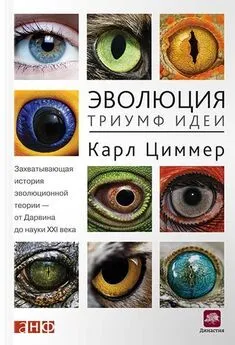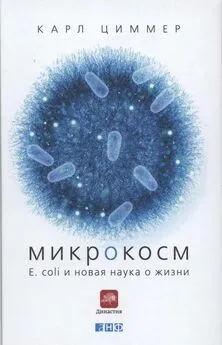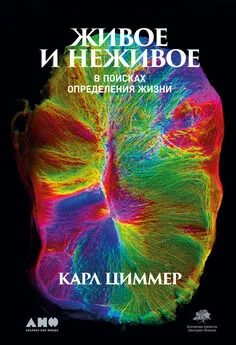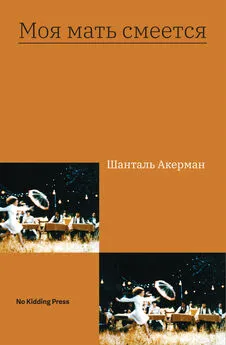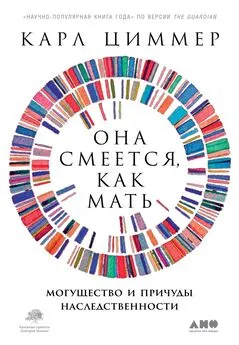Карл Циммер - Она смеется, как мать [Могущество и причуды наследственности] [litres]
- Название:Она смеется, как мать [Могущество и причуды наследственности] [litres]
- Автор:
- Жанр:
- Издательство:Литагент Альпина
- Год:2020
- Город:Москва
- ISBN:978-5-0013-9210-1
- Рейтинг:
- Избранное:Добавить в избранное
-
Отзывы:
-
Ваша оценка:
Карл Циммер - Она смеется, как мать [Могущество и причуды наследственности] [litres] краткое содержание
И культура, и традиции, география и экономика, технологии и то, в каком состоянии мы оставим планету, наконец. По мере развития науки появляется все больше способов вмешиваться в разные формы наследственности, что открывает потрясающие возможности, но одновременно ставит новые проблемы.
Технология CRISPR-Cas9, используемая для редактирования генома, генный драйв и создание яйцеклетки и сперматозоида из клеток кожи – список открытий растет с каждым днем, давая достаточно поводов для оптимизма… или беспокойства. В любом случае прежним мир уже не будет.
Карл Циммер знаменит своим умением рассказывать понятно. В этой важнейшей книге, которая основана на самых последних исследованиях и научных прорывах, автор снова доказал свое звание одного из лучших научных журналистов в мире.
Она смеется, как мать [Могущество и причуды наследственности] [litres] - читать онлайн бесплатно ознакомительный отрывок
Интервал:
Закладка:
“Crime of Scientific Zeal, The.” 1981. New York Times, June 5, editorial.
Cubas, P., C. Vincent, and E. Coen. 1999. “An Epigenetic Mutation Responsible for Natural Variation in Floral Symmetry.” Nature 401: 157–61.
Curtis, Benjamin. 2013. The Habsburgs: The History of a Dynasty. London: Bloomsbury.
Cutter, Calvin. 1850. A Treatise on Anatomy, Physiology, and Medicine: Designed for Colleges, Academies, and Families; with One Hundred and Fifty Engravings. Boston: Benjamin B. Mussey.
Cyranoski, David. 2017. “China’s Embrace of Embryo Selection Raises Thorny Questions.” Nature 548: 272.
Dacks, Joel В., Mark C. Field, Roger Buick, Laura Eme, Simonetta Gribaldo, Andrew J. Roger, Céline Brochier-Armanet, and Damien P. Devos. 2016. “The Changing View of Eukaryogenesis – Fossils, Cells, Lineages and How They All Come Together.” Journal of Cell Science 129: 3695–3703.
da Graca, J. V., E. S. Louzada, and J. W. Sauls. 2004. “The Origins of Red Pigmented Grapefruits and the Development of New Varieties.” Proceedings of the International Society of Citriculture 1: 369–74.
Dalgaard, Carl-Johan and Holger Strulik. 2016. “Physiology and Development: Why the West Is Taller than the Rest.” Economic Journal 126, no. 598, 1–32.
Danaei, Goodarz, Kathryn G. Andrews, Christopher R. Sudfeld, Günther Fink, Dana Charles McCoy, Evan Peet, Ayesha Sania, Mary C. Smith Fawzi, Majid Ezzati, and Wafaie W. Fawzi. 2016. “Risk Factors for Childhood Stunting in 137 Developing Countries: A Comparative Risk Assessment Analysis at Global, Regional, and Country Levels.” PLOS Medicine 13: e1002164.
Dannemann, Michael, Aida M. Andrés, and Janet Kelso. 2016. “Introgression of Neandertal-and Denisovan-like Haplotypes Contributes to Adaptive Variation in Human Toll-like Receptors.” American Journal of Human Genetics 98: 22–33.
Dare, Helen. 1905. “Luther Burbank: The Wizard of Horticulture.” San Francisco Sunday Call, June 25.
Dar-Nimrod, Ilan, and Steven J. Heine. 2011. “Genetic Essentialism: On the Deceptive Determinism of DNA.” Psychological Bulletin 137: 800–18.
________, Ilan, Benjamin Y. Cheung, Matthew B. Ruby, and Steven J. Heine. 2014. “Can Merely Learning about Obesity Genes Affect Eating Behavior?” Appetite 81: 269–76.
Darwin, Charles. 1839. Questions About the Breeding of Animals. London: Stewart and Murray. http://darwin-online.org.uk/content/frameset?itemID=F2628&viewtype=text&pageseq=l(accessed July 23, 2017).
________. 1859. On the Origin of Species by Means of Natural Selection. London: John Murray.
________. 1868. The Variation of Animals and Plants Under Domestication. London: John Murray.
________. 1871. “Pangenesis.” Nature 3: 502–03.
Daubin, Vincent, and Gergely J. Szöllosi. 2016. “Horizontal Gene Transfer and the History of Life.” Cold Spring Harbor Perspectives in Biology. doi: 10.1101/cshperspect.a018036.
Davenport, Charles B. 1899. Statistical Methods, with Special Reference to Biological Variation. New York: Wiley.
________. 1908. Inheritance in Canaries. Carnegie Institution of Washington.
________. 1911. Heredity in Relation to Eugenics. New York: H. Holt.
________. 1917. “The Effects of Race Intermingling.” Proceedings of the American Philosophical Society 56: 364–68.
Davenport, Gertrude C, and Charles B. Davenport. 1910. “Heredity of Skin Pigmentation in Man.” American Naturalist 44: 641–72.
Davidson, R. G., H. M. Nitowsky, and B. Childs. 1963. “Demonstration of Two Populations of Cellsin the Human Female Heterozygous for Glucose-6-Phosphate Dehydrogenase Variants.” Proceedings of the National Academy of Sciences of the United States of America 50: 481–85.
Davies, G., A. Tenesa, A. Payton, J. Yang, S. E. Harris, D. Liewald, X. Ke, and others. 2011. ”Genome-Wide Association Studies Establish That Human Intelligence Is Highly Heritable and Polygenic.” Molecular Psychiatry 16: 996–1005.
Dawkins, Richard. 1976. The Selfish Gene. Oxford: Oxford University Press, 1976.
________. 2016. The Selfish Gene. 40th Anniversary Edition. Oxford: Oxford University Press.
Day, Troy, and Russell Bonduriansky. 2011. “A Unified Approach to the Evolutionary Consequences of Genetic and Nongenetic Inheritance.” American Naturalist 178: E18–36.
Dean, Lewis G., Gill L. Vale, Kevin N. Laland, Emma Flynn, and Rachel L. Kendal. 2014. ”Human Cumulative Culture: A Comparative Perspective.” Biological Reviews of the Cambridge Philosophical Society 89: 284–301.
________, Rachel L. Kendal, Steven J. Schapiro, Bernard Thierry, and Kevin N. Laland. 2012.”Identification of the Social and Cognitive Processes Underlying Human Cumulative Culture.” Science 335: 1114–18.
Deary, Ian J. 2012.”Looking for ‘System Integrity’ in Cognitive Epidemiology.” Gerontology 58: 545–53.
________, and Lawrence J. Whalley. 2009. A Lifetime of Intelligence: Follow-up Studies of the Scottish Mental Surveys of 1932 and 1947. Washington, DC: American Psychological Association.
deBoer, Fredrik. 2017. “Disentangling Race from Intelligence and Genetics.” Blog, April 10.
https://fredrikdeboer.com/2017/04/10/disentangling-race-from-intelligence-and-genetics/(accessed September 11, 2017).
Deichmann, Ute. 2010. “Gemmules and Elements: On Darwin’s and Mendel’s Concepts and Methods in Heredity.” Journal for General Philosophy of Science 41: 85–112.
________. 2016. “Why Epigenetics Is Not a Vindication of Lamarckism – and Why That Matters.” Studies in History and Philosophy of Biological and Biomedical Sciences 57: 80–82.
DeLong, G. Robert. “A Career in Child Neurology: Explorations at the Frontiers.” Journal of Child Neurology 25: 1051–62.
Dennis, Carina. 2003. “Special Section on Human Genetics: The Rough Guide to the Genome.” Nature 425: 758–59.
Department of Health, UK. 2014. “Mitochondrial Donation: Government Response to the Consultation on Draft Regulations to Permit the Use of New Treatment Techniques to Prevent the Transmission of a Serious Mitochondrial Disease from Mother to Child.” London: Public Health Directorate / Health Science and Bioethics Division.
“Derbyshire Sisters Rose and Daisy Picked as Embryos to Beat Killer Disease.” 2014. Derby Telegraph, May 15.
Der Sarkissian, Clio, Morten E. Allentoft, Maria C. Ávila-Arcos, Ross Barnett, Paula F. Campos, Enrico Cappellini, Luca Ermini, and others. 2015. “Ancient Genomics.” Philosophical Transactions of the Royal Society В 370: 1660, 2013038. doi: 10.1098/rstb.2013.0387.
Desai, R. G., and W. P. Creger. 1963. “Maternofetal Passage of Leukocytes and Platelets in Man.” Blood 21: 665–73.
________, E. McCutcheon, B. Little, and S. G. Driscoll. 1966. “Fetomaternal Passage of Leukocytesand Platelets in Erythroblastosis Fetalis.” Blood 27: 858–62.
Devanapally, Sindhuja, Snusha Ravikumar, and Antony M. Jose. 2015. “Double-Stranded RNA Made in C. Elegans Neurons Can Enter the Germline and Cause Transgenerational Gene Silencing.” Proceedings of the National Academy of Sciences of the United States of America 112: 2133–38.
D’Gama, Alissa M., Ying Geng, Javier A. Couto, Beth Martin, Evan A. Boyle, Christopher M. LaCoursiere, Amer Hossain, and others. 2015. “Mammalian Target of Rapamycin Pathway Mutations Cause Hemimegalencephaly and Focal Cortical Dysplasia.” Annals of Neurology 77: 720–25.
Dhimolea, Eugen, Viktoria Denes, Monika Lakk, Sana Al-Bazzaz, Sonya Aziz-Zaman, Monika Pilichowska, and Peter Geek. 2013. “High Male Chimerism in the Female Breast Shows Quantitative Links with Cancer.” International Journal of Cancer 133: 835–42.
Dias, Brian G., and Kerry J. Ressler. 2014. “Parental Olfactory Experience Influences Behavior and Neural Structure in Subsequent Generations.” Nature Neuroscience 17: 89–96.
Didion, John P., Andrew P. Morgan, Liran Yadgary, Timothy A. Bell, Rachel C. McMullan, Lydia Ortiz de Solorzano, Janice Britton-Davidian, and others. 2016. “R2d2 Drives Selfish Sweeps in the House Mouse.” Molecular Biology and Evolution. doi: 10.1093/molbev/msw036.
Dietel, Manfred. 2014. “Boveri at 100: The Life and Times of Theodor Boveri.” Journal of Pathology 234: 135–37.
Dillingham, William P. 1911. Dictionary of Races or Peoples. Washington. DC: US Government Printing Office.
Disney, R. H. 2008. “Natural History of the Scuttle Fly, Megaselia scalaris.” Annual Review of Entomology 53: 39–60.
Dobzhansky, Theodosius. 1941. “The Race Concept in Biology.” Scientific Monthly 52: 161–65.
Doll, Edgar. 2012. “Deborah Kallikak, 1889–1978: A Memorial.” Intellectual and Developmental Disabilities 50: 30–32.
Donnelly, Kevin P. 1983. “The Probability That Related Individuals Share Some Section of Genome Identical by Descent.” Theoretical Population Biology 23: 34–63.
Dorr, Gregory Michael. 2008. Segregation’s Science: Eugenics and Society in Virginia. Charlottesville: University of Virginia Press.
Doudna, Jennifer A. 2015. “Genome-Editing Revolution: My Whirlwind Year with CRISPR.” Nature 528: 469.
________, and Emmanuelle Charpentier. 2014. “The New Frontier of Genome Engineering with CRISPR-Cas9.” Science 346: 1258096.
________, and Samuel H. Sternberg. 2017. A Crack in Creation: Gene Editing and the Unthinkable Power to Control Evolution. New York: Houghton Mifflin Harcourt.
Douglass, Frederick. 1848. The North Star, September 15.
________. 1855. My Bondage and My Freedom. New York: Auburn.
“Dr. Henry F. Osborn Dies in His Study.” 1935. New York Times, November 7, p. 23.
Dreyer, Peter, and W. L. Howard. 1993. A Gardener Touched with Genius: The Life of Luther Burbank. Santa Rosa: L. Burbank Home and Gardens.
Dröscher, Ariane. 2014. “Images of Cell Trees, Cell Lines, and Cell Fates: The Legacy of Ernst Haeckel and August Weismann in Stem Cell Research.” History and Philosophy of the Life Sciences 36: 157–86.
Du Bois, W. E. B. 1906. The Health and Physique of the Negro American. Atlanta: Atlanta University Press.
Duncan, Andrew W., Amy E. Hanlon Newell, Leslie Smith, Elizabeth M. Wilson, Susan B. Olson, Matthew J. Thayer, Stephen C. Strom, and Markus Grompe. 2012. “Frequent Aneuploidy Among Normal Human Hepatocytes.” Gastroenterology 142: 25–28.
Dunham-Snary, Kimberly J., and Scott W. Ballinger. 2015. “Mitochondrial-Nuclear DNA Mismatch Matters.” Science 349: 1449–50.
Dunlap, Knight. 1940. “Antidotes for Superstitions Concerning Human Heredity.” Scientific Monthly 51: 221–25.
Dunsford, I., С. C. Bowley. A. M. Hutchison, J. S. Thompson, R. Sanger, and R. R. Race. 1953. “A Human Blood-Group Chimera.” British Medical Journal 2: 81.
Du Plessis, Paul J., Clifford Ando, and Kaius Tuori, eds. 2016. The Oxford Handbook of Roman Law and Society. Oxford: Oxford University Press.
Dusheck, Jenny. 2016. “Girl’s Deadly Arrhythmia Linked to Mosaic of Mutant Cells.” Stanford Medicine News Center, September 26.
Duster, Troy. 2015. “A Post-Genomic Surprise. The Molecular Reinscription of Race in Science, Law and Medicine.” British Journal of Sociology 66: 1–27.
Читать дальшеИнтервал:
Закладка:
![Обложка книги Карл Циммер - Она смеется, как мать [Могущество и причуды наследственности] [litres]](/books/1075049/karl-cimmer-ona-smeetsya-kak-mat-moguchestvo-i-pr.webp)

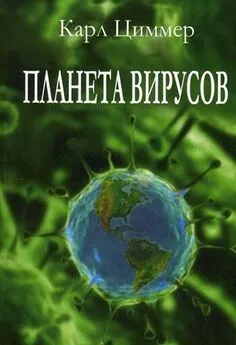
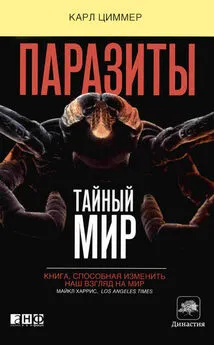

![Карл Циммер - Паразит – царь природы [Тайный мир самых опасных существ на Земле] [litres]](/books/1067054/karl-cimmer-parazit-car-prirody-tajnyj-mir-sam.webp)
